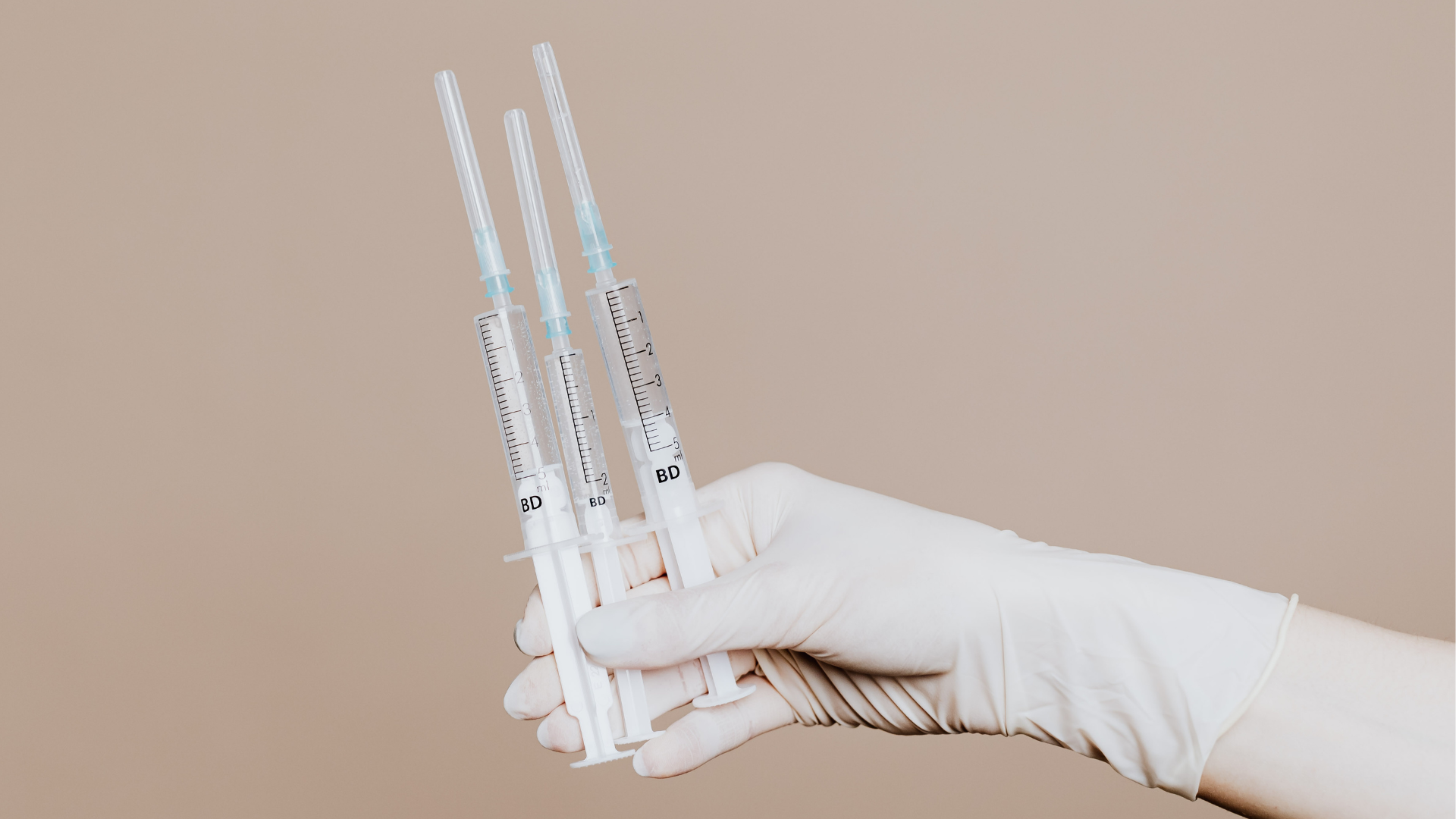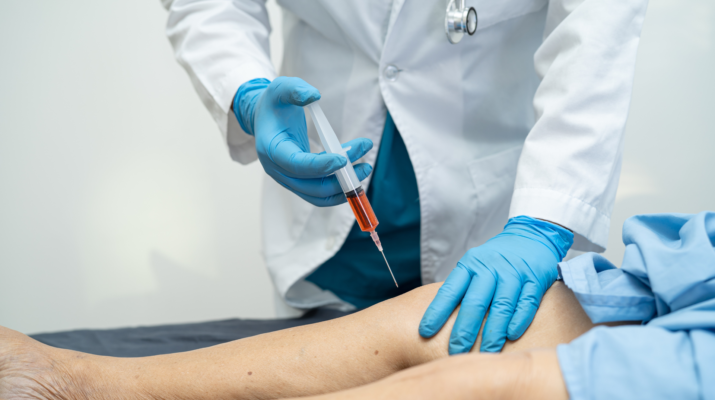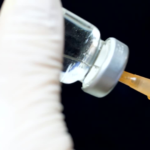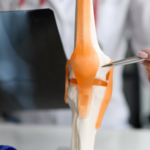
According to Safali et al. (2024), single or multiple doses of intra-articular injections of hyaluronic acid (HA) have shown efficacy in alleviating pain and enhancing function in patients with knee osteoarthritis (OA). The study underscores the potency of HA injections in providing symptomatic relief and elevating the quality of life for individuals suffering from knee OA.
For knee osteoarthritis (OA) patients, intra-articular hyaluronic acid injections for the knee can help manage their condition. This treatment can provide temporary relief from symptoms associated with knee OA. Among the many brand-name products available, healthcare providers often recommend Orthovisc and Monovisc to offer lasting relief for patients with knee OA.
This article will compare Orthovisc and Monovisc, their mechanisms of action, safety and efficacy, and the required dosage and administration.
Key Takeaways
- Orthovisc and Monovisc are intra-articular hyaluronic acid therapies for knee osteoarthritis (OA).
- Medical professionals can help patients understand the difference between Orthovisc and Monovisc and how both viscosupplementations can offer different yet effective approaches.
- In their respective clinical trials, Orthovisc and Monovisc effectively reduce pain and improve joint functionality.
- Medical professionals and patients can discuss whether Orthovisc’s three to four injections fit the patient’s needs, goals, and cost budgeting or whether Monovisc’s single injection can offer these benefits better.
About: Medica Depot is your trusted all-in-one supplier, offering a range of high-quality medical injectables and supplies. If you’re looking to buy Orthovisc, you can do so on Medica Depot quickly and easily. We offer a worry-free experience in searching for the best and most popular products on the market. Whether for health professionals, plastic surgeons, dermatologists, licensed estheticians, or other specialists, we can offer genuine, brand-name products you may need. With Medica Depot, we prioritize serving you better to improve the patient’s quality of life.
Introduction to Orthovisc and Monovisc
Intra-articular hyaluronic acid (HA) therapies, such as Orthovisc and Monovisc, can manage knee osteoarthritis by injecting HA directly into the affected joint. These injections aim to restore the physiologic viscoelasticity in the synovial fluid.
These therapies help reduce inflammation and prevent joint damage. Orthovisc and Monovisc are HA-based supplementation agents for treating knee osteoarthritis (OA).
Comparing Orthovisc and Monovisc for knee OA treatment is crucial as they have different origins, formulations, injection frequency, and clinical outcomes. It’s worth noting that individuals with knee OA should seek professional help to ensure a safe and effective treatment.
These medical professionals can assess the patient’s knee OA condition and determine the best treatment. They can also help patients understand the difference between Orthovisc and Monovisc and how both viscosupplementations can offer different yet effective approaches.
Formulation and Composition

Orthovisc and Monovisc are viscosupplements backed by hyaluronic acid (HA) potency. This HA substance naturally occurs in the body, particularly skin and joints. HA is the primary natural component found in the joint’s synovial fluid.
Orthovisc knee injections show a sterile mixture of highly purified hyaluronic acid derived from rooster combs. The HA found in this source is high-molecular-weight, mimicking the viscoelastic properties of natural synovial fluid.
Meanwhile, Monovisc is a sterile, non-pyrogenic viscoelastic solution of HA. It consists of ultra-pure, high-molecular-weight HA derived from bacterial cells. The formulation also involved a cross-linking process with a proprietary solution.
While both Orthovisc and Monovisc are hyaluronan-based viscosupplements used for knee osteoarthritis treatments, they have a crucial difference in their origin and formulation structure. Orthovisc derived their formulation’s HA from rooster combs with a linear chain structure, while Monovisc garnered their HA via bacterial cells and cross-linked in structure.
Mechanism of Action
It is necessary to understand the mechanism of action and how a new treatment can help treat knee osteoarthritis (OA). Viscosupplementation like Orthovisc and Monovisc requires direct administration into the knee joint to replenish the lost hyaluronic acid.
These two injections supplement the joint’s synovial fluid with hyaluronic acid (HA), acting as a lubricant and shock absorber. Both have shown effectiveness in reducing pain and improving joint functionality. When injected into the knee joint, Orthovisc and Monovisc offer lubrication and cushioning, providing temporary pain relief caused by knee OA.
The synovial fluid surrounds the joints, and over time, the HA in the fluid creases its quality and quantity. These viscosupplements add the HA into the synovial fluid to improve individuals’ joint function and mobility and deliver pain-free movement.
Orthovisc and Monovisc’s Clinical Efficacy

Orthovisc has proven its effectiveness in numerous studies. One such study, a randomized controlled trial conducted by Neustadt et al. (2005), encompassed 372 participants. This demonstrated that Orthovisc’s high molecular weight injection is a safe and effective treatment for knee osteoarthritis (OA), ranging from mild to severe cases.
Remarkably, 76% of the patients reported a significant improvement in their pain scores at week eight, showing more than a 20% improvement. This was notably higher than the 62% of control patients who reported similar improvements.
In addition to Orthovisc, Monovisc has undergone several clinical trials to evaluate its efficacy compared to other treatments. Petterson & Plancher (2019) conducted a randomized controlled trial comparing Monovisc to saline. This resulted in Monovisc offering a safe and effective therapy for providing significant pain reduction within two weeks.
Moreover, this study supports using Monovisc for patients with symptomatic knee osteoarthritis in patients older than 45. It is an efficient alternative for individuals wanting a non-surgical option and is not a candidate for total knee replacement.
In a clinical trial, the US Food and Drug Administration shared that Orthovisc’s multiple injections are non-inferior to Monovisc’s single-injection therapy. This shows that both viscosupplements can safely and effectively aid in treating patients’ knee osteoarthritis symptoms.
Dosing Regimens and Administration


A healthcare provider can offer viscosupplementation via intra-articular hyaluronic acid injections into the knee joint. They can recommend single injections or multiple injections. Each brand name, like Orthovisc and Monovisc, differs in its dosing regimen.
- Recommended Dosing Regimens for Orthovisc: Orthovisc knee injection typically requires a series of shots. Orthovisc dosage needs 30 mg or 2 mL injected into the affected knee weekly for three to four weeks. The effects of the medications may last an average of four to six months.
- Recommended Dosing Regimens for Monovisc: While Orthovisc needs multiple shots for the knees, medical professionals only need to administer a single injection for Monovisc. The recommended dose is 88 mg or 4 mL into the affected knee joint. Providers must use separate syringes for each knee.
The US Food and Drug Administration has approved Orthovisc knee injection and Monovisc. According to their respective prescribers, healthcare providers must administer these shots using an aseptic injection technique and standard intra-articular injection site preparation and precautions.
The main difference between these supplements lies in the frequency and dosage of their injections. Medical professionals and patients can discuss whether Orthovisc’s three to four injections fit the patient’s needs, goals, and cost budgeting or whether Monovisc’s single injection can offer these benefits better.
Safety Profiles
Due to the hyaluronic acid component of Orthovisc and Monovisc, most individuals generally tolerate these injections. However, it’s worth noting that patients can expect side effects, and understanding these can help them make informed decisions for their healthcare.
Medical professionals may experience a few Orthovisc injection problems, such as injection site reactions or patient discomfort. They can efficiently manage these issues and the Orthovisc side effects patients may experience after their shots.
- Pain at the injection site
- Swelling at the injection site
- Redness
- Bruising
- Itching
Orthovisc clinical trials also showed the common adverse events that rarely occur in patients after Orthovisc knee injections. If these symptoms and side effects persist, promptly contact your trusted medical professionals for medical attention.
- Arthralgia
- Back Pain
- Headache
Conversely, Monovisc-treated patients can also expect side effects after the treatment. These symptoms may typically subside once the body adapts to the medicine injected. However, if these persist, they may require immediate medical attention.
- Pain
- Swelling
- Heat
- Rash
- Itching
- Bruising
- Redness
Conclusion
Knee osteoarthritis is a prevalent condition that affects millions of people worldwide. Fortunately, intra-articular hyaluronic acid therapies like Orthovisc and Monovisc offer a non-surgical solution to alleviate pain and improve joint functionality. Both viscosupplements have shown clinical efficacy in various studies, although they differ in origin, formulation, injection frequency, and clinical outcomes.
Patients should understand the difference between Orthovisc and Monovisc and how both injections can offer different yet practical approaches to managing knee osteoarthritis. With the help of medical professionals and the right treatment plan, individuals with knee osteoarthritis can enjoy a better quality of life.
FAQs
1) Why seek medical help for knee osteoarthritis treatment?
Healthcare providers can determine the most effective treatment plan based on the patient’s knee osteoarthritis condition.
2) Should patients expect side effects after Orthovisc and Monovisc injections?
Common side effects may occur after treatment, but patients can expect these symptoms to subside as their bodies adapt to the medicine. However, if any local injection site reaction or symptoms persist, contact your doctor immediately.
3) What is the difference between Orthovisc and Monovisc injections?
Orthovisc is a series of three to four injections made from rooster combs, while Monovisc is a single injection made from bacterial fermentation.
4) How frequently can Orthovisc and Monovisc injections be administered?
Orthovisc injections are given once a week for three to four weeks, while Monovisc is a single injection. The frequency may vary based on the provider’s recommendation.
References
- Safali, S., Ertaş, E. S., Özdemir, A., & Cataklı, D. (2024). Evaluation of single and multiple hyaluronic acid injections at different concentrations with high molecular weight in the treatment of knee osteoarthritis. BMC musculoskeletal disorders, 25(1), 164. https://doi.org/10.1186/s12891-024-07200-y
- Patient Information MONOVISCTM High Molecular Weight Hyaluronan. (n.d.). In accessdata.fda.gov. US Food and Drug Administration. Retrieved April 22, 2024, from https://www.accessdata.fda.gov/cdrh_docs/pdf9/P090031d.pdf
Buy aesthetic products refers to the act of purchasing items that are specifically designed for enhancing or maintaining beauty, often related to skincare, cosmetics, or procedures in the field of aesthetics. These products can include a wide range of items intended to improve the appearance and health of the skin, hair, and body. Here are some examples of aesthetic products that individuals might purchase:
-
Skincare Products: Including cleansers, moisturizers, serums, and treatments targeting specific skin concerns such as acne, aging, hyperpigmentation, and sensitivity.
-
Cosmetics: Makeup products such as foundations, concealers, eyeliners, lipsticks, and eyeshadows designed to enhance facial features and achieve desired looks.
-
Hair Care Products: Shampoos, conditioners, styling products, and treatments to maintain and improve the health and appearance of hair.
-
Dermatological Treatments: Prescription or over-the-counter treatments for medical conditions like acne, eczema, psoriasis, or rosacea.
-
Aesthetic Devices: Equipment used for professional treatments including laser devices, microneedling pens, radiofrequency devices, and IPL (Intense Pulsed Light) machines.
-
Injectable Aesthetics: Products such as dermal fillers and botulinum toxin (Botox) used to enhance facial contours, reduce wrinkles, and achieve smoother skin.
-
Nutritional Supplements: Supplements aimed at promoting skin health, hair growth, and overall well-being, often containing vitamins, minerals, and antioxidants.
-
Home Use Beauty Devices: Devices like facial cleansing brushes, LED light therapy masks, and microcurrent devices designed for at-home skincare treatments.






